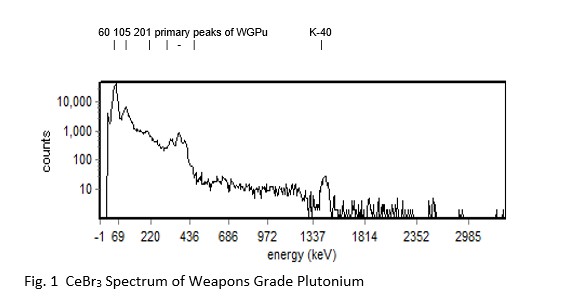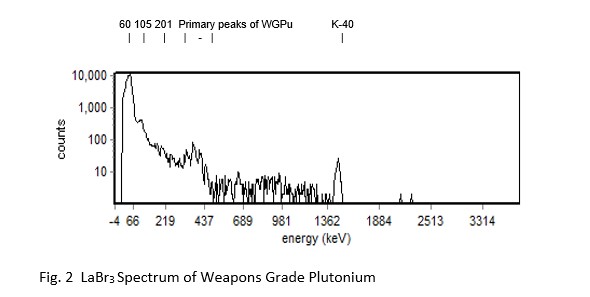January 24th, 2019 - Characteristics of Common Radionuclide Detectors
This paper, written by James H. McQuaid, presents characteristics of three of the most common room temperature detectors used to obtain spectroscopic grade detection of radionuclides. These detectors are commonly selected to achieve both sensitivity and adequate resolution for the identification of radionuclides.
The best sensitivity for detecting the presence of a radioactive source is typically a large NaI detector. For this purpose, the 3x3 inch NaI detector is readily available and most commonly selected. Good energy resolution can also be obtained with large NaI detectors. Generally, these detectors give 7% resolution at 1332 keV. If the application does not require high sensitivity but primarily good resolution in the low to mid energy for the identification of special nuclear material, then select either a CeBr3 or LaBr3 detector. Both CeBr3 and LaBr3 will give good resolution for weapons-grade plutonium (WGPu). However, CeBr3 will give the best resolution for energies at and below 186 keV for weapons-grade uranium. LaBr3 detectors will outperform CeBr3 at high energies (typically 3% at 662 keV) but will degrade rapidly at low energies becoming worse than NaI at 60 keV. LaBr3 also has drawbacks because of internal radioactivity. This is caused by the internal contamination of 138La which increases the overall background count. This added background can be specifically seen by a gamma-ray at 1438 keV which will raise the background in the region of natural occurring potassium-40 (40K) at 1461 keV [1][2]. The 138La contamination also produces strong barium X-rays in the range of 31 to 38 keV which is seen as a very large peak. This is observed when comparing Fig. 1 and Fig. 2. Fig 2 shows LaBr3 with a very broad peak at 60 keV. This peak is made up of barium X-rays from the 138La contamination and americium-241 (241Am) from the WGPu. This peak is quite broad because of the poor resolution of LaBr3 at about 100 keV and below.
Generally, high energy applications are easily met using NaI detectors. An exception to this could be the need of identifying cesium-137 (137Cs) in a high background of radium where either CeBr3 or LaBr3 could be used. Either of these higher resolution detectors will clearly separate the 137Cs peak at 662 keV from the barium-214 peak of radium at 609 keV (NaI does not have the resolution to separate these two energy peaks).
The performance of CeBr3 and LaBr3 is shown in Fig. 1 and 2 for WGPu. These spectra show peaks from 60 keV to the primary peaks of WGPu (332, 375 and 413 keV). When examining Figure 2, the elevated background cannot be fairly compared with Fig. 1 because the vertical scale is unfortunately not the same. However, this spectrum was obtained to show the improved resolution of LaBr3 at high energies as seen at the 40K peak (1461 keV) and the poor resolution at 60 keV. Even though the scale is not the same, similar resolution can be seen for the primary energies of WGPu in the mid 300 keV area.


In recent years CeBr3 has become readily available in a 2x2 inch detector giving a vast improvement in efficiency and sensitivity over the 1.5x1.5 inch size (the efficiency improvement is about 29%). It is important to recognize that detector efficiency does not imply sensitivity performance (the sensitivity of a 3x3 NaI is greater than any 2x2 detector because of its larger volume). When in search for the proper detector there may be specific circumstances and special applications. Please be advised that BNC is always available for consultation.
REFERENCES
[1] Comparison of LaBr3:Ce and NaI(Tl) Scintillators for Radio-Isotope Identification Devises,
B. D. Milbrath, et. al., Pacific Northwest National Laboratory (PNNL)
[2] Scintillation and Detection Characteristics of High-sensitivity CeBr3 Gamma-ray Spectrometers,
P. Schotanusf, et. al., Scionix Holland BV
